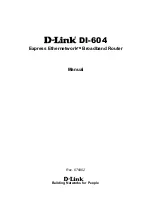
8 Routing configuration
Routing configuration allows a static and dynamic methods to set up routing between networks.
The network administrator configures static routes by entering routes directly into the routing
table. Static routing has the advantage of being predictable and easy to configure.
Alternatively, you can enable dynamic routing using RIP for IPv4 or RIPng for IPv6. The Routing
Information Protocol (RIP) is the most common used method for dynamically maintaining routing
tables in small networks. RIP uses a distance vector-based approach to routing. Routes are
chosen to minimize the distance vector, or hop count, which serves as a rough estimate of
transmission cost.
Viewing routing status
The Status page shows whether RIP or RIPng are enabled, and displays the current IPv4 and
IPv6 routing tables.
The routing tables include the information necessary to forward a packet along the best path
toward its destination. Each packet contains information about its origin and destination. When
a packet is received, a network device examines the packet and matches it to the routing table
entry providing the best match for its destination. The table then provides the device with
instructions for sending the packet to the next hop on its route across the network.
Содержание R110
Страница 6: ...6 ...
Страница 10: ...10 Deploying the HP R110 R120 ...
Страница 22: ...22 Using the Wizard Setup ...
Страница 50: ...50 LAN configuration ...
Страница 72: ...72 Wireless configuration ...
Страница 80: ...80 VPN configuration ...
Страница 88: ...88 Routing configuration ...
Страница 98: ...98 Firewall configuration ...
Страница 130: ...130 Tools ...
Страница 134: ...134 ...
Страница 142: ...142 ...
















































